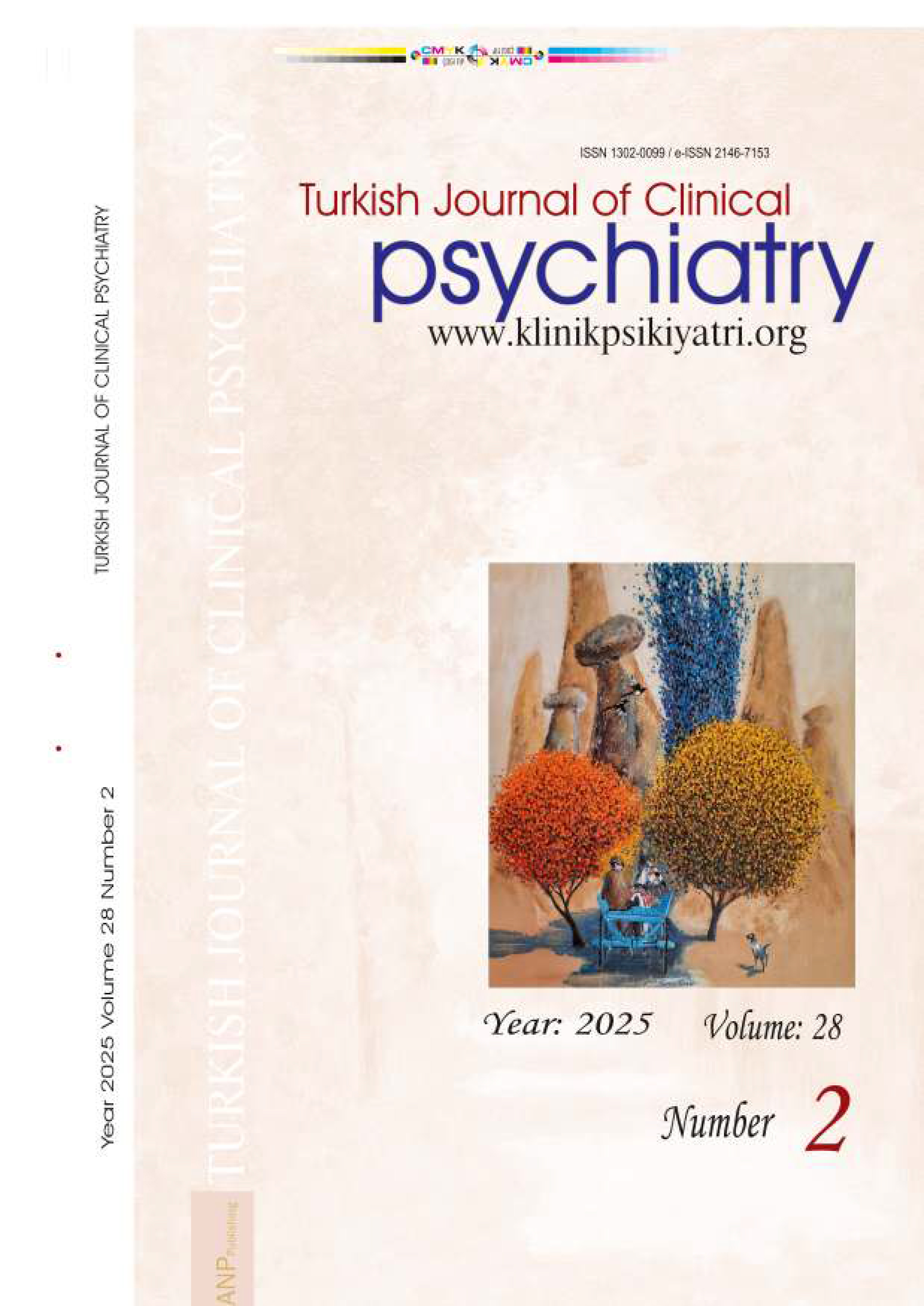





Volume: 15 Issue: 1 - 2012
| RESEARCH ARTICLE | |
| 1. | The Effects of Atrial Natriuretic Peptide on Behavioral Despair in Rats Exposed to Chronic Immobilization Stress Ejder Akgün Yıldırım, Murat Mengi, Sibel Turhan, Ertan Yurdakoş Pages 7 - 17 Objectives: Anxiolytic efficacy of atrial natriuretic peptide (ANP) was shown in experimental studies. In our study, we evaluated the effect of intracerebroventricular administration of ANP on behavioral despair in rats exposed to chronic immobilization stress. Method: In this study, Wistar-Albino male adult rats weighing 250- 300 g have been used. Study animals were randomly assigned into four groups. 1-Control group: Group did not undergone surgical intervention and did not received substance injection (n=8). 2-Sham operated group: Group was administered 5 pi physiologic serum via intracerebroventricular route (n=8). 3-Chronic immobilization group: Group was exposed to 7 minutes daily immobilization stress for two weeks and was administered 5 pi physiologic serum via intracerebroventricular route (n=8). 4-ANP group: Group was exposed to 7 minutes daily immobilization stress for two weeks and administered 0.5 pg/5 pi intracerebroventricular ANP (n=8). As behavioral test, Porsolt's swimming test was used. The results were analyzed statistically by using one way ANOVA-Tukey and Wilcoxon tests. Results: In the Porsolt's Swimming test, the control and the sham operated group animals exhibited the well-documented behavioral despair by a significant increase in immobilization time when compared with that of the pre-test. On the other hand, compared with the control and the sham operated group, animals in the chronic immobilization group and ANP administered group did not show behavioral despair obviously. Conclusion: These results suggest that in Porsolt's swimming test, both chronic mild stress and intracerebroventricular ANP administration in the rats exposed to chronic mild (immobilization) stress have preventive effects on the development of behavioral despair, but the direct role of ANP in these effects is not clear. |
| 2. | Distribution of Psychiatric Disorders in Patients with Obstructive Sleep Apnea Syndrome Haluk Hıdıroğlu, Evrim Özkorumak, İsmail Ak Pages 18 - 25 Objectives: The relationship of Obstructive Sleep Apnea Syndrome (OSAS) and other medical conditions has been studied widely while relationship between OSAS and mental health is not sufficently investigated. The aim of this study is to determine distribution of mental disorders within clinical features of OSAS. Method: Patients with a diagnosis of OSAS according to polysomnography composed the sample of this study (n=102). The patients were classified according to ICSD-2 (The international Classification of Sleep Disorders). Montgomery Asberg Depression Rating Scale, Beck Depression Inventory, The Epworth Sleepiness Scale were administered respectively. Psychiatric diagnosis were made with the interview for DSM-IV Axis I Disorders (SCID-I). Results: Among 102 patients, 19.6% (n=20) was mild, 29.4% (n=30) was moderate, 51.0% (n=52) was severe form of OSAS. Relationship of mild-moderate OSAS with BMI was significant (p=0.010). %31.4 (n=32) of patients had one additional psychiatric diagnosis according to SCID-I, 22.5% (n=23) had more than one psychiatric diagnosis and 46.1% (n=47) did not have any. Conclusion: The detected depression rate was correlated with many studies which had reported higher depression rates in OSAS. In this study the rate of anxiety disorders was higher than healthy population while similar or lower than the rate estimated in studies with OSAS patients. Mental disorders in medical diseases are important clinical syndromes effecting morbidity and mortality. Regarding this issue, further studies which compare different subgroups is needed. |
| 3. | The Clinical and Sociodemographic Features of Late Onset Schizophrenia Patients in a Psychiatry Clinic Özge Saraçlı, Hasret Ozan Keser, İsmet Kaygısız, Adnan Atalay, Ülkem Öztürk Pages 26 - 32 Objective: The late onset schizophrenia patients had symptoms similar to those of schizophrenia patients like paranoid delusions, persecutory delusions and auditory hallucinations but with less affective flattening, negatif signs and family history of schizophrenia. The purpose of this paper was overwiew the clinic features and treatment response of late onset schizophrenia patients. Method: We collected data about sociodemographic features, DSM-IV diagnosis, clinic features, period of disease, inpatient periods, medication and treatment response, blood levels of vitamin B12 and folic asid, imaging technique results of 26 late onset schizophrenia patients that was treated in Psychiatry Clinic of Karaelmas University from 2001 to 2010. Results: The mean age of patients was 54.2±6.25 (range: 45-69), 15 (57.7%) were male, 11 (42.3%) were female. The mean age of onset was 41.8±2.4 (range: 40-48). Delusions were present in 85%, hallucinations were present in 46%, ajitation were present in 30%, apathy were present in 27% and cognitif problems were present in 12% of the patients. The structural abnormalities were present in 8 of 1 7 patients who had brain imaging. The patients who had abnormal imaging results have longer inpatient periods. The vitamin B12 and folic asid deficiency were present in 54% and 4% of the patient, respectively. Conclusion: it is important that doing brain imaging and other medical assesments in the late onset schizophrenia. Further systematic research into its epidemiology, phenomenology, genetics, biological and psychosocial issues, course and outcome are necesary for a beter understanding of this condition. |
| 4. | Psychiatric Evaluation of Child and Adolescent Forensic Cases Muhammed Ayaz, Ayşe Burcu Ayaz, Nusret Soylu Pages 33 - 40 Objectives: The aim of this study was to examine the diagnosis of mental disorders and sociodemografic variables of children and adolescents who referred to child psychiatry outpatient department with the request of criminal report. Method: Children and adolescents aged 6-18 years who referred to Sakarya Training and Research Hospital Child Psychiatry Outpatient Department for criminal reports were examined retrospectively in terms of diagnosis of mental diseases, intelligence levels and sociodemographic characteristics. The study was carried out on the basis of delinquent children (n = 51), cases of abuse (n=100), and cases of early marriage (n=26) that make up the vast majority of criminal cases. Results: Mental disorders were detected in 71% of cases of abuse, 56.7% of delinquent children, and 11.5% of adolescents with request of early marriage. The most common mental disorders were post- traumatic stress disorder among abuse cases, conduct disorder among cases of delinquency, and major depressive disorder among cases of early marriage. Conclusion: Our study revealed that high rates of mental disorders were diagnosed in cases of abuse and delinquent children. Our results highlighted the importance of training for different requirements of criminal cases in the field of forensic child psychiatry and taking necessary precautions for children and adolescents that were subjected to forensic events. Mental health services that provide comprehensive screening, assessment and treatment of mental disorders for these children and adolescents should be developed. |
| 5. | Turkish Validity and Reliability Study of Health Anxiety inventory (Weekly Short Form) in Cases of Panic Disorders Özgün Karaer Karapıçak, Kevser Aktaş, Selçuk Aslan Pages 41 - 48 Objection: The aim of this study was to carry out the validity and reliability of the "Health Anxiety Inventory - Short From" in Turkish. Method: The present study included the patients with panic disorder (N= 67) and healthy controls (N= 44). The data were collected by using Health Anxiety Inventory - Short Form, Panic- Agoraphobia Scale and Hamilton Anxiety Rating Scale. The Health Anxiety Inventory- Short Form was carried out one week later than the first interview. The Health Anxiety Inventory- Short Form is a self-test inventory produced by Salkovskis et al. (2002) that composed of 18 items evaluating health anxiety, independent from the current health status. Results: In the evaluation of validity among the patient group and health controls, mean Health Anxiety Inventory- Short Form scores was 10.1 ±4.9 in healthy controls and was 27.9 ±11.4 in the patient group (pcO.OOOI) in the first interview. In the second interview the similar results were obtained. For the similar scale validity evaluation, the correlation of these results with the Hamilton Anxiety Rating Scale scores were examined and a positive correlation was found between the scores (Pearson Correlation: 0.46; pcO.OOOI). For the evaluation of reliability, the internal validity was carried out in all participants and the internal validity coefficient Cronbach Alpha value was found to be 0.91. Conclusion: The adaptation Health Anxiety Inventory- Short Form into Turkish language was found to be a valid and reliable instrument in evaluating health anxiety in patients with panic disorder. |
| 6. | Subjective Well-Being at Work: Investigating of Psychometric Properties of Utrecht Work Engagement Scale Ali Eryılmaz, Tayfun Doğan Pages 49 - 55 Objectives: The concept of subjective well-being, which means an individual's evaluation of and judgment about his life, is also important for work life. According to work life literature, subjective well-being is treated with the concept of work engagement. Work engagement is not a single dimensional structure. It has three important elements: Vigor, dedication and absorption Work engagement is related with individuals' physical and mental health. In literature, work engagement is measured with Utrecht Work Engagement Scale (UWES). This study examines the reliability and validity of UWES on Turkish sample. Method: A total of 352 individuals between ages 20-70- (105 female and 246 male) completed UWES. Confirmatory factor analysis and internal consistency methods were conducted in order to investigate validity and reliability of UWES. Results: Results indicated that the Turkish version of the UWES had an adequate level of reliability and validity. The factor structure of the Turkish version of the scale was found to be similar to the original version. Conclusion: The UWES is shown in the study to be an instrument aiming to measure work engagement of individuals. It was also demonstrated that the scale had reasonable internal consistency. Through the investigation of work engagement in an increased number of studies, it would be possible to better understand the concept of work engagement and the psychological consequences of work engagement, and also to improve individuals' subjective well-being. |
| REVIEW | |
| 7. | From Depressive Symptamotology to Major Depression: Clinical Spectrum Aslı Akın Aslan, Burcu Akın Sarı, Aslı Kuruoğlu Pages 56 - 64 In recent days some depressive moods as sadness, mourning and enervation that aren't defined in DSM-IV, have been sensed by plenty of people. Some of these feelings have mentioned in literature. With this fact subthreshold depressive symptoms that do not meet the DSM IV diagnostic criteria for major depressive disorder and classified as Depressive Disorder Not Otherwise Specified (DD-NOS) was associated with significant functional impairments and risk for future major depressive episode. After all there is still no standard treatment for subthreshold depression. In the absence of dysphoria or anhedonia, the patient with other depressive symptoms does not fit any category of depressive disorders. However, limited studies show the reduction of functioning in these patients highlight the importance of diagnosis and treatment of depressive spectrum disorders. Subthreshold depression may seen in many cases of psychiatric or medical disorders which also can be associated with life events and increasing risk of developing major depression. Altough there are some studies about diagnosis and treatment of subthreshold depressive symptoms in specific sample groups such as elderly population or the people with other medical illness; the results are not suitable for general population. Further well-designed studies are needed to determine suitable scales for diagnosis of subthreshold depressive symptoms as well as when and how to interfere these symptoms to standardize the treatment. This review aims to define and focus on clinical significance of subthreshold depressions. |










